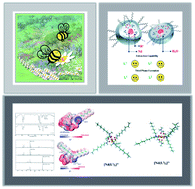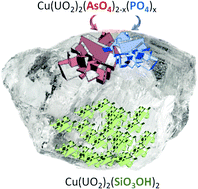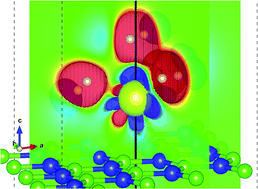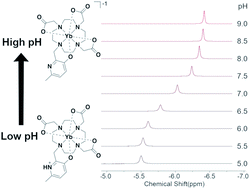Themed collection Shining a Light on the f-Block

Gamma radiolytic stability of the novel modified diglycolamide 2,2′-oxybis(N,N-didecylpropanamide) (mTDDGA) for grouped actinide extraction
The radiolysis behavior of a new diglycolamide for solvent extraction of actinides and lanthanides was studied. The observed degradation rate was lower than for the reference molecule and 22 degradation compounds were identified.

RSC Adv., 2022,12, 12416-12426
https://doi.org/10.1039/D1RA08761D
Pu(III) and Cm(III) in the presence of EDTA: aqueous speciation, redox behavior, and the impact of Ca(II)
Combined advanced spectroscopy and solubility studies provide evidence for the formation of novel calcium-containing and hydrolyzed (Cm,Pu)(III)–EDTA complex(es).

RSC Adv., 2022,12, 9478-9493
https://doi.org/10.1039/D1RA09010K
Lanthanide-doped bismuth-based nanophosphors for ratiometric upconversion optical thermometry
Lanthanide-doped bismuth-based nanospheres can be rapidly synthesized within 1 minute for upconversion luminescence ratiometric temperature detection.

RSC Adv., 2022,12, 8743-8749
https://doi.org/10.1039/D2RA01181F
Structural and spectroscopic studies of spontaneously formed crystalline Eu(III)–aliphatic dicarboxylates at room temperature
This study captures the transition of the coordination modes of aliphatic dicarboxylate ligands from side-on to end-on binding, which is illustrated in malonate bindings involving a combination of side-on and end-on modes.

RSC Adv., 2022,12, 4047-4053
https://doi.org/10.1039/D1RA07565A
Study on the extraction of lanthanides by isomeric diglycolamide extractants: an experimental and theoretical study
The ‘imbalance’ of the coordination ability of the two Oamide affects the extraction performance by experimental and theoretical study.

RSC Adv., 2022,12, 790-797
https://doi.org/10.1039/D1RA07020G
Post synthetically modified IRMOF-3 for efficient recovery and selective sensing of U(VI) from aqueous medium
Four IRMOFs following PSM strategy were prepared. The MOFs were characterized by different techniques and were investigated for U(VI) sorption. PSM MOFs displayed impressive fluorescent sensing and selectivity of U(VI) over competing metal ions.

RSC Adv., 2021,11, 28126-28137
https://doi.org/10.1039/D1RA02971A
A comparative study on the coordination of diglycolamide isomers with Nd(III): extraction, third phase formation, structure, and computational studies
The inhomogeneous interactions of M–Oamide in the LII ligand result in differences between the metal-ion extraction performances of two isomeric ligands.

RSC Adv., 2021,11, 27969-27977
https://doi.org/10.1039/D1RA04222J
A class of novel luminescent layered double hydroxide nanotubes
The incorporation of triply charged lanthanides in layered double hydroxides (LDHs) enables the curvature of the LDH sheets, unlocking the possibility of using a soft templating strategy to produce a class of luminescent, hierarchical LDH nanotubes.

RSC Adv., 2021,11, 24747-24751
https://doi.org/10.1039/D1RA03948B
Multispectral upconversion nanoparticles for near infrared encoding of wearable devices
Multispectral transparent films of upconversion nanoparticles are developed for near-infrared encoding of wearable devices including contact lenses and patch devices.

RSC Adv., 2021,11, 21897-21903
https://doi.org/10.1039/D1RA03572J
Synthesis of luminescent thorium-based metal–organic frameworks with 1,2,4,5-tetrakis(4-carboxyphenyl)benzene
Three new thorium-based MOFs based on 1,2,4,5-tetrakis(4-carboxyphenyl)benzene (H4TCPB) were obtained under a similar reaction system (metal salt, ligand, solvent, and acid are the same).

RSC Adv., 2021,11, 17431-17436
https://doi.org/10.1039/D1RA01742J
All near-infrared multiparametric luminescence thermometry using Er3+, Yb3+-doped YAG nanoparticles
Four completely new NIR luminescence temperature readouts in the second and third biological windows are demonstrated with YAG:Er3+, Yb3+ nanoparticles.

RSC Adv., 2021,11, 15933-15942
https://doi.org/10.1039/D1RA01647D
Bright sky-blue fluorescence with high color purity: assembly of luminescent diphenyl-anthracene lutetium-based coordination polymer
Pure sky-blue fluorescence (FWHM: 50 nm) from lutetium-based coordination polymer with diphenyl-anthracene derivative is demonstrated for the first time.

RSC Adv., 2021,11, 6604-6606
https://doi.org/10.1039/D0RA10795F
Selective extraction of trivalent actinides using CyMe4BTPhen in the ionic liquid Aliquat-336 nitrate
Improving the kinetics of selective An(III) extraction from nitric acid feed solutions into an ionic liquid based solvent: combining CyMe4BTPhen with TODGA in Aliquat-336 nitrate.

RSC Adv., 2021,11, 6014-6021
https://doi.org/10.1039/D0RA10445K
Highly fluorescent aryl-cyclopentadienyl ligands and their tetra-nuclear mixed metallic potassium–dysprosium clusters
Alkyl substituted triaryl-cyclopentadienyl ligands with aggregation-induced emission enhancement (AIEE) properties and their applications in the syntheses of novel chloride bridged tetra-nuclear mixed potassium–dysprosium metallocenes.

RSC Adv., 2020,10, 39366-39372
https://doi.org/10.1039/D0RA05316C
Lanthanide contraction effect and white-emitting luminescence in a series of metal–organic frameworks based on 2,5-pyrazinedicarboxylic acid
Influence of the lanthanide contraction effect on the formation of a series of new MOFs and their wide colour range luminescence spectra.

RSC Adv., 2020,10, 38252-38259
https://doi.org/10.1039/D0RA08485A
Tb(III)-doped nanosheets as a fluorescent probe for the detection of dipicolinic acid
A new fluorescent probe based on terbium(III)-doped nanosheets was designed for detecting low-levels of dipicolinic acid (DPA), a biomarker of bacterial spores.

RSC Adv., 2020,10, 37500-37506
https://doi.org/10.1039/C9RA09695G
Novel light-emitting clays with structural Tb3+ and Eu3+ for chromate anion detection
For the first time, Tb3+ and Eu3+ were incorporated into the framework of synthetic saponite by a one-pot hydrothermal procedure, obtaining luminescent materials with interesting photophysical properties, exploited for the fluorescent sensing of the chromate anion in water.

RSC Adv., 2020,10, 29765-29771
https://doi.org/10.1039/D0RA05693F
Visible and NIR emitting Yb(III) and Er(III) complexes sensitized by β-diketonates and phenanthroline derivatives
Long lifetimes and high quantum yields are obtained in the reported complexes.

RSC Adv., 2020,10, 27815-27823
https://doi.org/10.1039/D0RA05539E
The impact of alicyclic substituents on the extraction ability of new family of 1,10-phenanthroline-2,9-diamides
Some unexpected “structure–extraction properties” patterns were found for new family of 1,10-phenanthroline-2,9-diamide derived ligands.

RSC Adv., 2020,10, 26022-26033
https://doi.org/10.1039/D0RA05182A
A multi-technique study of altered granitic rock from the Krunkelbach Valley uranium deposit, Southern Germany
A multi-technique elemental and microphase analysis of altered granitic rock from the Krunkelbach Valley uranium deposit, Black Forest, Southern Germany.

RSC Adv., 2020,10, 25529-25539
https://doi.org/10.1039/D0RA03375H
Lanthanide complexes based on a new bis-chelating carbacylamidophosphate (CAPh) scorpionate-like ligand
A new bis-chelating scorpionate type CAPh ligand and its lanthanide complexes in solid state and solution.

RSC Adv., 2020,10, 24808-24816
https://doi.org/10.1039/D0RA04714G
Dual stimuli-responsive lanthanide-based phosphors for an advanced full-color anti-counterfeiting system
Dual stimuli-responsive lanthanide-based phosphors were prepared for constructing a multilevel full color anti-counterfeiting system, augmenting the security level for information protection.

RSC Adv., 2020,10, 15573-15578
https://doi.org/10.1039/D0RA01594F
Insight into anomalous hydrogen adsorption on rare earth metal decorated on 2-dimensional hexagonal boron nitride: a density functional theory study
The central rare earth cerium atom and underlying apolar B–N bonds in two-dimensional hexagonal boron nitride facilitate a unique arrangement of hydrogen molecules which leads to fairly strong adsorption of eight hydrogen molecules per metal atom.

RSC Adv., 2020,10, 12929-12940
https://doi.org/10.1039/D0RA01835J
Tuning slow magnetic relaxation behaviour in a {Dy2}-based one-dimensional chain via crystal field perturbation
Two novel {Dy2}-based one dimensional chain compounds with similar structures have been prepared and subtle crystal field of Dy(III) ion can perturb their slow magnetic relaxation behaviors.

RSC Adv., 2020,10, 11831-11835
https://doi.org/10.1039/D0RA01604G
Mixed Tb/Dy coordination ladders based on tetra(carboxymethyl)thiacalix[4]arene: a new avenue towards luminescent molecular nanomagnets
The single crystals of the two isostructural Tb3+- and Dy3+-based coordination polymers (HL3–Tb and HL3–Dy) were structurally characterized, and their photophysical properties were investigated, together with their corresponding solid solutions.
![Graphical abstract: Mixed Tb/Dy coordination ladders based on tetra(carboxymethyl)thiacalix[4]arene: a new avenue towards luminescent molecular nanomagnets](/en/Image/Get?imageInfo.ImageType=GA&imageInfo.ImageIdentifier.ManuscriptID=D0RA01263G&imageInfo.ImageIdentifier.Year=2020)
RSC Adv., 2020,10, 11755-11765
https://doi.org/10.1039/D0RA01263G
A Ln(III)-3-hydroxypyridine pH responsive probe optimized by DFT
The favorable pH response and coordination properties of the 3-hydroxypyridyl group indicate its potential for further development as a dual responsive-reporter group for Ln(III) MRS probes.

RSC Adv., 2020,10, 8994-8999
https://doi.org/10.1039/C9RA11058E
Functionalized natural cellulose fibres for the recovery of uranium from seawater
Simple organophosphonate functionalization of sisal fibres yields materials that extract uranium from sea water with high efficiency.

RSC Adv., 2020,10, 6654-6657
https://doi.org/10.1039/D0RA00601G
Crystallization of colourless hexanitratoneptunate(IV) with anhydrous H+ countercations trapped in a hydrogen bonded polymer with diamide linkers
Centrosymmetric hexanitratoneptunate(IV) crystallizes with anhydrous proton countercations trapped in a hydrogen bonded polymer with diamide linker molecules to give colourless crystals.

RSC Adv., 2020,10, 6082-6087
https://doi.org/10.1039/C9RA10090C
Circularly polarised luminescence (CPL) control of oligopeptide–Eu(III) hybridized luminophores by interaction with peptide side chains
The CPL sign is controllable by varying the number of naphthalene units and peptide/Eu(III) coordination ratio.

RSC Adv., 2020,10, 2575-2580
https://doi.org/10.1039/C9RA09708B
About this collection
Welcome to this themed collection on “Shining a Light on the f-Block”, guest edited by Dr Robert Baker (Trinity College Dublin).
Whilst the chemistry of the f-block (Ln and An) elements are not as well investigated as the transition metals, fascinating results have been forthcoming in the last 10 years. These results have challenged our ideas on bonding and led to refinement of theories on bonding and magnetism to name but two.
In this collection, numerous facets of the interest, both fundamental and applied, in f-block chemistry are showcased. The photophysics and magnetism of the lanthanides are highlighted in numerous applications, including biochemistry whilst there is still room for the coordination and organometallic chemistry of the lanthanides to be extended and explored.
The chemistry of the actinides is generally more challenging both experimentally and from a safety and regulatory framework. Separation science has an important role here for treatment of legacy, current and future nuclear wastes, both experimentally and theoretically. Advances in state-of-the-art spectroscopy highlights what can be achieved for small concentrations of U, Pu and Cm. The chemical creativity on display in this selection shows that forays into the f-block can be both satisfying and rewarding.